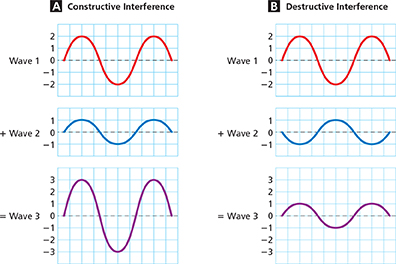Constructive Interference
Imagine a child being pushed on a swing by her mother. If the mother times her pushes correctly, she will push on the swing just as the child starts to move forward. Then the mother's effort is maximized and the child gets a boost to go higher. In the same way, the amplitudes of two waves can add together. Constructive interference occurs when two or more waves combine to produce a wave with a larger displacement.
What happens if you and a friend send waves with equal frequencies toward each other on a jump rope? Figure 12A shows how constructive interference produces a wave with an increased amplitude. The crests of waves 1 and 2 combine to make a higher crest in wave 3. At the point where two troughs meet, wave 3 has a lower trough.
Destructive Interference
What happens if the mother has bad timing while pushing on the swing? Instead of working to boost her daughter upward, some of her effort is wasted, and the girl will not swing as high. In much the same way, destructive interference can reduce the amplitude of a wave. Destructive interference occurs when two or more waves combine to produce a wave with a smaller displacements.
In Figure 12B, two waves with the same frequency meet, but this time the crest of wave 1 meets the trough of wave 2. The resulting wave 3 has a crest at this point, but it is lower than the crest of wave 1. Destructive interference produces a wave with a reduced amplitude.
Figure 12 Two waves with equal frequencies travel in opposite directions. The motions are graphed here to make it easier to see how the waves combine. A When a crest meets a crest, the result is a wave with an increased amplitude. B When a crest meets a trough, the result is a wave with a reduced amplitude.
Making Generalizations How is the amplitude of wave 3 related to the amplitudes of waves 1 and 2?
 d
d




